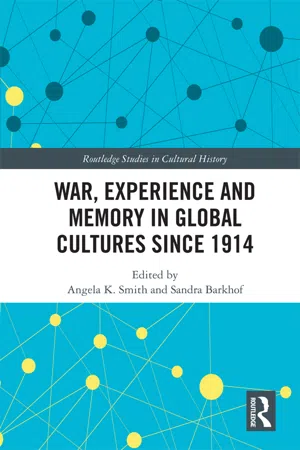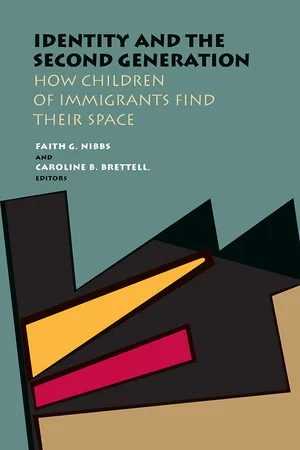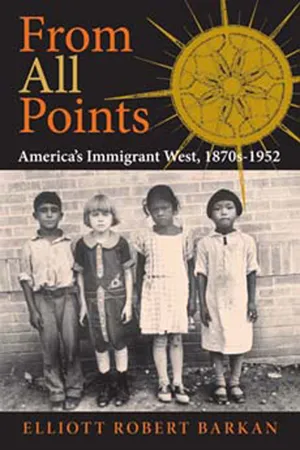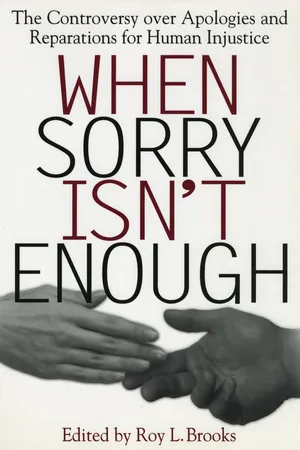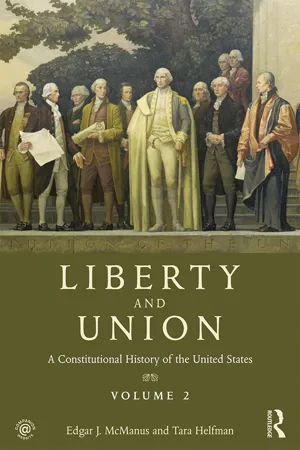History
Japanese Americans in WW2
During World War II, Japanese Americans faced discrimination and were subjected to forced relocation and internment by the United States government. This unjust treatment was a result of widespread anti-Japanese sentiment following the attack on Pearl Harbor. Despite this adversity, many Japanese Americans served with distinction in the military, and their resilience and contributions have been recognized in subsequent years.
Written by Perlego with AI-assistance
Related key terms
6 Key excerpts on "Japanese Americans in WW2"
- Angela K. Smith, Sandra Barkhof(Authors)
- 2018(Publication Date)
- Routledge(Publisher)
The fundamental American story is told from the perspective of Caucasians. Since the contemporary Civil Rights Movement for African-Americans, their history has begun to be included in the American story. The role of Asian Americans in the American story remains much less visible. Even the narrower story of America’s participation in World War Two largely denies Asian Americans space. Ironically, the most highly decorated military unit in contemporary American history was an all-Japanese unit in World War Two, even though most Americans would not know this fact. Shimomura’s artist’s statement addresses the inability or indifference of Americans to recognise distinctions between Asian people: “During World War II this insensitivity was expressed by their failure to recognize the difference between the Japanese people and Americans of Japanese descent.” 39 Each lithograph depicts an Asian American from the Minidoka camp standing behind barbed wire juxtaposed with traditional Japanese figures in the foreground. McCormick notes, “It is unclear who is being kept in, and who is out of the space delineated by the fence.” 40 Half of the internees depicted in this series are young children, but he also includes a grandmother, a young man graduating from high school, another in military uniform, and several adults. The Internees are depicted in a modern American style, while the Japanese males are costumed as traditional wood block figures reminiscent of the souvenir prints tourists brought back from Japan—the exoticised Japanese- eBook - ePub
Identity and the Second Generation
How Children of Immigrants Find Their Space
- Faith G. Nibbs, Caroline B. Brettell(Authors)
- 2016(Publication Date)
- Vanderbilt University Press(Publisher)
I am proud of my service in the 442nd, although I don’t talk about it much. After the war, people would come up to me and say, “Did you belong to that famous regiment during World War II?” and I’d say, “Yes, I was part of that.” Then they’d say, “Oh, you boys were so wonderful!” People realized the Greatest Generation wasn’t just whites. Japanese Americans sacrificed a lot for our country as well. I think it really changed perceptions of us.Even those prewar nisei who were too young to serve in the 442nd shared similar sentiments. “Being a Japanese American is a matter of pride for me,” Mike, a board member of the JAHSSD, stated during our interview. He continued as follows:It’s because of what our generation was able to accomplish during the war years, especially the veterans. You know what they did, the sacrifices they made, and it was a matter of great pride for all of us. What they did made it so much easier for the rest of us to assimilate to American society. We earned our Americanness. Like our veterans memorial says, “Dedicated to all Japanese American veterans who defended their country for the right to be called Americans.” Those are my words.Because of their racialization as enemy aliens during World War II and the ethnic discrimination they experienced during this period, second-generation Japanese Americans therefore demanded inclusion in the nation-state by demonstrating their loyalty and patriotism as Americans. By emphasizing their national identity as Americans of Japanese ancestry, they were among the first Asian Americans to challenge racially exclusionary notions of national belonging where being American is associated with being racially white. When Bob, the former president of the JAHSSD, speaks about the internment of Japanese Americans to current high school students, he told me that he ends his talk by asking them: “What’s an American supposed to look like? Tell me, what’s an American supposed to look like? An American is what is in your head and your heart, not what you look like or the color of your skin. Look around you—there are other types of Americans than just white ones.” - eBook - ePub
From All Points
America's Immigrant West, 1870s-1952
- Elliott Robert Barkan(Author)
- 2007(Publication Date)
- Indiana University Press(Publisher)
60Passage contains an image
CHAPTER THIRTY-THREE
The Second World War’s Other Enemy AliensItalians and Germans
W E HAVE COME A LONG WAY since the 1960s, when a major U.S. history textbook included only one sentence about Japanese Americans during the Second World War. But there were other ethnic groups whose histories during the war years were a long time coming. Some stories have moved into the spotlight, particularly those surrounding Mexican Americans as both essential workers and unprovoked victims. Still others were long denied the coverage they deserved. Stephen Fox began his 1990 oral history of Italians during this war with a brief account of four immigrant men who committed suicide when faced with the self-perceived shame of being classified as enemy aliens. They had to leave homes and businesses after years spent carving out new lives in America. The men ranged in age from 57 to 65 and tragically ended their lives in front of a moving train, with a knife, at the end of a noose, and by leaping from a building. None had become citizens. If they had, none of these extreme measures would likely have occurred. In fact, Milano Ripoli, of the Italian Welfare Agency, also learned of three others in San Francisco who, fearing they would be put in concentration camps, also committed suicide.1The wives of many immigrant men learned before mid-December 1941 that they, too, were classified as enemy aliens and, seven weeks later, that, as non-citizens, they would have to leave their homes and businesses in the Prohibited Zone along the coast. They now more fully understood the price of having failed to apply for citizenship. Steve Antongiovanni (of Eureka, California) recalled that “In 1930 [shortly after his mother arrived] there was no immediate need for my mother to become a citizen.” “Learning English was not a priority,” for “she was in the house all the time and there were Italians all around.” She did, however, acquire citizenship in 1942. Also in Eureka, Gino Casagrande indicated that his mother received her citizenship after the war. Why not sooner, he was asked. He replied, “Here’s an immigrant that can’t speak the language. She’s a housewife. She worked in [their] bakery...; she took care of three children. ... The only thing she was worried about was taking care of her family.” In Monterey, Vitina Spadaro described how his mother “All of a sudden ... realized that she was considered an alien, so she wanted to be part of this country, she wanted to be an American like my father and me.” She studied English and the U.S. Constitution and did become naturalized.2 - eBook - ePub
Voices of World War II
Contemporary Accounts of Daily Life
- Priscilla Roberts(Author)
- 2012(Publication Date)
- Greenwood(Publisher)
4. Mary Tsukamoto recorded her recollections when she was prominent in the campaign to obtain compensation for surviving Japanese American internees. How might this have affected both what she included in her reminiscences and also what she might have chosen not to record?TOPICS TO CONSIDER
1. In late 1944 the U.S. Supreme Court paved the way for the release of the internees when it decided that the existing Executive Order had given the government only the authority to remove Japanese Americans from the West Coast, but not to imprison the evacuees, leaving undecided the question whether additional legislation to do so would be constitutionally invalid. Why did the Supreme Court take more than two years to issue this decision?2. Since September 11, 2001, many Americans have shown intense fear and suspicion of Muslim Americans and immigrants of Middle Eastern or South Asian descent, regarding all as potential terrorists. On many occasions, the U.S. government has also ridden roughshod over the civil rights of individuals and groups American officials believe may threaten the country’s security. Are there any discernible parallels between the current position of Muslim Americans and that of Japanese Americans during World War II? Can one ever justify destroying or ignoring democratic values in the interests of defending democracy?Further InformationDaniels, Roger. Concentration Camps, North America: Japanese in the United States and Canada during World War II. Updated ed. Malabar, FL: Krieger Publications, 1993.The Florin Japanese American Citizens League Oral History Project, California State University, Sacramento, California.Harth, Erica, ed. Last Witnesses: Reflections on the Wartime Internment of Japanese Americans. New York: Palgrave, 2001.Hayashi, Brian Masaru. Democratizing the Enemy: The Japanese American Internment. Princeton, NJ: Princeton University Press, 2004.Irons, Peter. Justice at War. Berkeley: University of California Press, 1993.Kashima, Tetsuden. Judgment without Trial: Japanese American Imprisonment during World War II - eBook - ePub
When Sorry Isn't Enough
The Controversy Over Apologies and Reparations for Human Injustice
- Roy L. Brooks(Author)
- 1999(Publication Date)
- NYU Press(Publisher)
During World War II the United States expanded its internment program and national security investigations to Latin America on the basis of “military necessity.” On the government’s invitation, approximately 3,000 residents of Latin America were deported to the United States for internment to secure the Western Hemisphere from internal threats and to supply exchanges for American citizens held by the Axis. Most of these deportees were citizens, or their families, of Japan, Germany and Italy. Although this program was not conducted pursuant to Executive Order 9066, an examination of the extraordinary program of interning aliens from Latin America in the United States completes the account of federal actions to detain and intern civilians of enemy or foreign nationality, particularly those of Japanese ancestry.What began as a controlled, closely monitored deportation program to detain potentially dangerous diplomatic and consular officials of Axis nations and Axis businessmen grew to include enemy aliens who were teachers, small businessmen, tailors and barbers—mostly people of Japanese ancestry. Over two-thirds, or 2,300, of the Latin American internees deported to the United States were Japanese nationals and their families; over eighty percent came from Peru.1 About half the Japanese internees were family members, including Nisei, who asked to join their husbands and fathers in camps pending deportation to Japan; family members were classified as “voluntary internees.”2Underlying these deportations was the fear of Japanese attack in Latin America, particularly at the Panama Canal, which produced suspicion of Latin American Japanese. But a curious wartime triangle trade in Japanese aliens for internment developed, too. Some Latin American countries, particularly Peru, deported Japanese out of cultural prejudice and antagonism based on economic competition; the United States, in turn, sought Latin American Japanese internees to exchange with Japan for American citizens trapped in territories Japan controlled. The same dynamic often affected Germans and Italians.From Report of the Commission on Wartime Relocation and Internment of Civilians, Personal Justice Denied (Washington, D.C.: U.S. Government Printing Office, 1982), pp. 305–14.The model of the Latin American deportation and internment program was developed in Panama. Before the war, the United States had agreed orally and informally with Panamanian officials to intern Japanese nationals during wartime. After the Pearl Harbor attack, Panama declared war on the Axis and froze Japanese assets. Japanese aliens were arrested by Panamanian and American agents for security reasons because they were near the Canal Zone. The War Department instructed the Commanding General of the Caribbean Defense Command to construct an internment camp in Panama for enemy aliens.3 Panama later agreed to transfer internees to the United States to be traded for Western Hemisphere nationals held in Japan.4 - eBook - ePub
Liberty and Union
A Constitutional History of the United States, volume 2
- Edgar McManus, Tara Helfman(Authors)
- 2013(Publication Date)
- Routledge(Publisher)
The forced relocation and detention of 112,000 persons of Japanese ancestry living on the West Coast was the one major violation of constitutional rights during the war. More than 70,000 of those relocated and detained were American citizens. No charges of any sort were filed against them; they were rounded up and separated from their homes, jobs, and property for no other reason than their racial identity. The program was set in motion in February of 1942 when President Roosevelt issued Executive Order No. 9066 authorizing the secretary of war and the military commanders on the West Coast to restrict, exclude, or detain any persons deemed to be a threat to military security. Roosevelt issued the order on his authority as commander in chief, but Congress backed up the order with legislation giving the order statutory approval. The alleged justification for these extraordinary measures was military security. It was feared that Japan might follow up the success at Pearl Harbor with an attack on the American mainland. Should this happen, what would prevent Japanese Americans in the area from assisting the enemy with acts of sabotage and espionage? There was not a particle of evidence to support such fears, but the government was determined to take no chances.Figure XIX.3 Children stand outside an assembly center in Pinedale, California, awaiting transfer (1942).Library of Congress, Prints and Photographs Division, [LC-USZ6-1651]Pursuant to the president’s order, military authorities on the West Coast issued a series of orders applicable only to persons of Japanese ancestry. They were put under a special curfew, forbidden to leave the area without permission, and required to register with the military for removal to relocation centers. Failure to obey the directives was a punishable offense. The program posed a cruel dilemma for Japanese Americans. On the one hand, they were forbidden to leave the area where they were deemed to be a security threat; on the other, they would be subject to relocation and detention if they remained. The whole point of the program was to isolate them behind barbed wire for an indefinite period. Some would remain in detention camps for up to four years, not for anything they had done, but because of their race. It was a measure of preventive detention applied to a whole population. That most of the detainees were United States citizens did not matter; their ancestry outweighed all other considerations.
Index pages curate the most relevant extracts from our library of academic textbooks. They’ve been created using an in-house natural language model (NLM), each adding context and meaning to key research topics.
